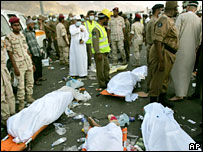
Many of the victims were from the Middle East and Asia
|
Saudi officials have denied that police could have done more to stop a stampede during the Hajj pilgrimage, now known to have killed at least 362 Muslims.
A spokesman for the interior ministry said tighter controls on the massive crowds could have caused more deaths.
Relatives have been scrutinising rows of photographs of unidentified bodies, as officials announced the higher toll.
The stone-throwing ritual in Mina has seen many stampedes, but the number of dead is the highest in 16 years.
After a crush in 2004, barriers were added and stewards positioned at the site to improve safety.
But interior ministry spokesman Maj Gen Mansour al-Turki told the BBC's Newshour programme the dangers would only increase if crowd controls were tightened further.
"People insist that they want to finish their Hajj in the way they think is right and you have a limited effect in using policemen to control people in this regard," he said.
"You cannot really control them by force because if you do probably you will increase the problem because you will have people pushing you. We had so many police officers today who were injured in this situation."
Maj Gen Turki told a news conference that of the dead, 203 had been identified, of whom 85 were women, reports the AP news agency.
Jawaid Aktar, the assistant chief constable of West Yorkshire police in the UK who has just returned from Saudi Arabia, said the authorities were well prepared for the Hajj.
"The authorities were very well organised given the scale of the event," he told BBC Radio Leeds.
 |
HAJJ DISASTERS
2004: 251 trampled to death in stampede
2003: 14 are crushed to death
2001: 35 die in stampede
1998: At least 118 trampled to death
1997: 343 pilgrims die and 1,500 injured in fire
1994: 270 killed in stampede
1990: 1,426 pilgrims killed in tunnel leading to holy sites
1987: 400 die as Saudi authorities confront pro-Iranian demonstration
|
Relatives crowded round photo displays of the dead, as Husni Tibawi, an Algerian doctor accompanying thousands of Algerian pilgrims complained the authorities could do more to help with the identification process.
The stampede took place at the foot of the bridge of Jamarat, where pilgrims hurl stones at three pillars representing the spot where the devil is said to have appeared to Abraham.
Officials said the crush happened after pieces of luggage spilled from moving buses in front of one of the entrances to the bridge, causing pilgrims to trip.
At least 289 people were injured, according to the Saudi Health Minister Hamad bin Abdullah al-Maneh.
Many of the victims were from the Middle East and Asia, with at least 44 Pakistanis, 28 Indians, 12 Turks, 10 Egyptians four Chinese, two Indonesians and two Britons reported to be among the dead.
More than two million people were thought to have been performing the rite at the time.
Bulldozers
Suad Abu Hamada, an Egyptian pilgrim, told AP he heard screaming and "saw people jumping over each other".
Bulldozers cleared the area after the bodies were removed to allow the ceremony to continue.
The pilgrims were returning via Mina after performing the Tawaf al-Wada, a farewell ceremony that involves walking around the Kaaba - a cube-like building in the centre of Mecca's Great Mosque - seven times.
The stoning is the riskiest ritual of the Hajj, as worshippers jostle to try to target the stones, often causing weaker pilgrims to fall under foot.
In 2004, more than 200 pilgrims were trampled to death while performing the same ceremony.
The latest deadly stampede comes days after more than 70 people died when a hostel for pilgrims collapsed in the Saudi city of Mecca.
The Hajj is one of the five pillars of Islam and every able-bodied adult Muslim is obliged to perform it at least once in their lives.

